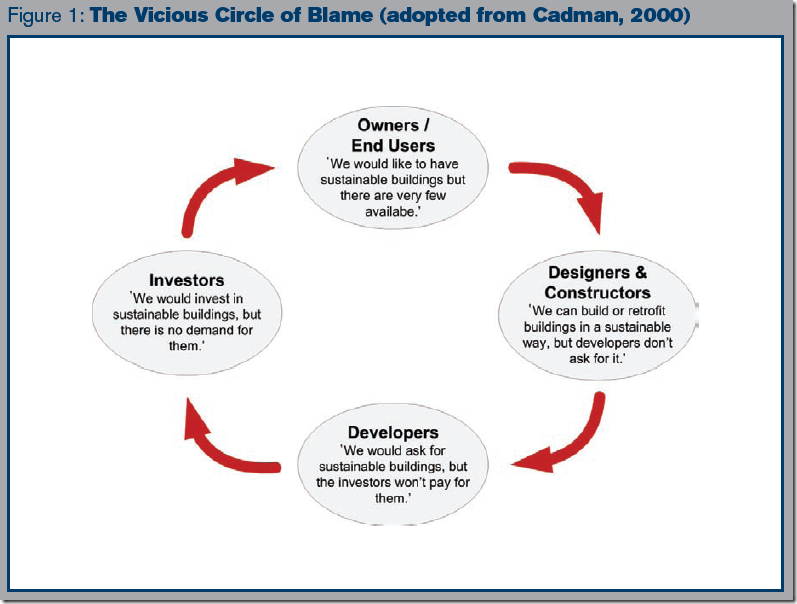The boom of so-called green offices is currently spottable in lots of countries around Europe. A few moths ago the most sustainable office building in the world, the Edge, was finished in the south of Amsterdam. What does move the sustainable development in the corporate private sector forward?
In 2000 Cadman developed a scheme called the vicious circle of blame, consisting of 4 stakeholders involved in the development of commercial real estate; end-user (tenant), designer, developer and investor. The interrelations and the motives and triggers indicate why is it difficult for each of these stakeholders to initiate the change and start demanding sustainable office buildings. Looking at the issue of sustainability through the glasses of company very much differs from the perspective of the municipality, government or citizens. The business of majority of companies is profit driven and thus for them sustainability makes sense only if it could be translated into profit increase. For a company, sustainability mostly needs to be financially feasible and preferable.
There are several ways, how company as tenant may (financially) benefit from being located in green building, building with low energy demand, building certified by one of the energy certifications such as LEED or BREEAM:
- increasing its corporate social responsibility (CSR) and thus improving the image
- lowering the operation (energy) costs
- by better indoor environmental quality the productivity of the workers is increased
These reasons are by far the most mentioned ones, with the CSR being on the top. The problem is that they are almost impossible to measure and thus hardly directly translated into the financial benefits for the company. Only the savings on the energy costs may be easily determined, however unfortunately some researches showed that for most of the tenants while deciding about their future office, sustainability is usually not as one of the top priorities as deciding factors; these are mostly the location, accessibility and rent level. Sustainability is seen as added value, but tenants are not really yet willing to pay more for it.
Such thinking makes it very hard to break the circle of blame. Especially since constructing the green certified office building is more expensive than building a regular building (the estimate is approximately 2-3% increase in construction costs for LEED Platinum building). The investors would want to have the green buildings in their portfolios only if they will be able to acquire higher rents from the tenants. The developers would want to build sustainable offices only if they can sell them with higher price to investors.
In reality the circle of blame needs to be broken from all the sides simultaneously using speculative constructing. In speculative development stakeholders just "believe" that eventually the sustainability will pay off if they will pursue with it. Nowadays being sustainable company is mostly about image, promoting itself and being thus favored by the customers. This trend will however consequently speed up the development as well. Everyone wants to have, what they see around themselves. Thus more and more LEED and BREEAM certified office buildings are being built today and this development will most probably even increase in the future. Further questions are at stake such as whether these certifications really enhance sustainability in its whole width or whether it wouldn't been even more sustainable instead of building new LEED Platinum buildings, to retrofit the already existing ones, which are very often vacant? These are other stories...
Reference:
RICS (2015). Breaking the circle of blame for sustainable buildings. Retrieved from https://www.joinricsineurope.eu/uploads/files/Sustainable%20buildings...BreakingtheViciousCircleofBlame.pdf
Eichholtz, P., Kok, N., Quigley, J. (2010). Doing Well By Doing Good? Green Office Buildings. American Economic Review
